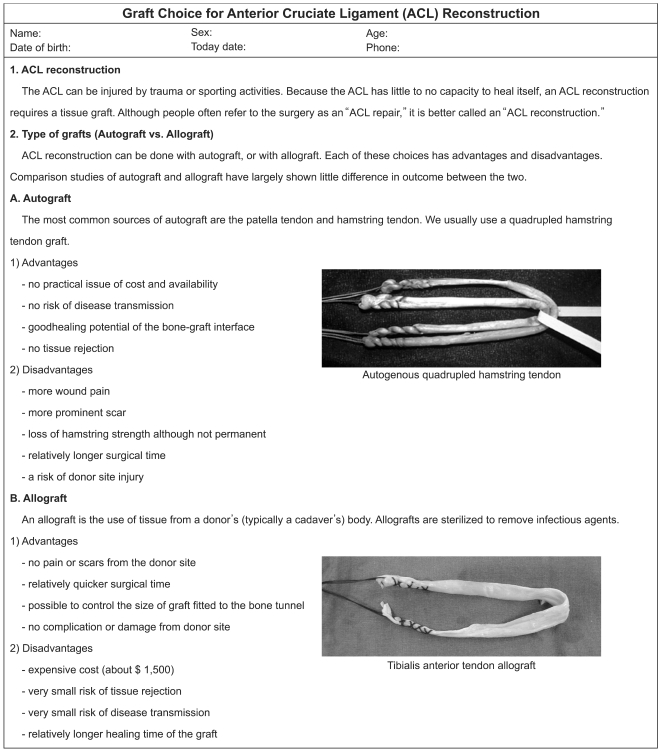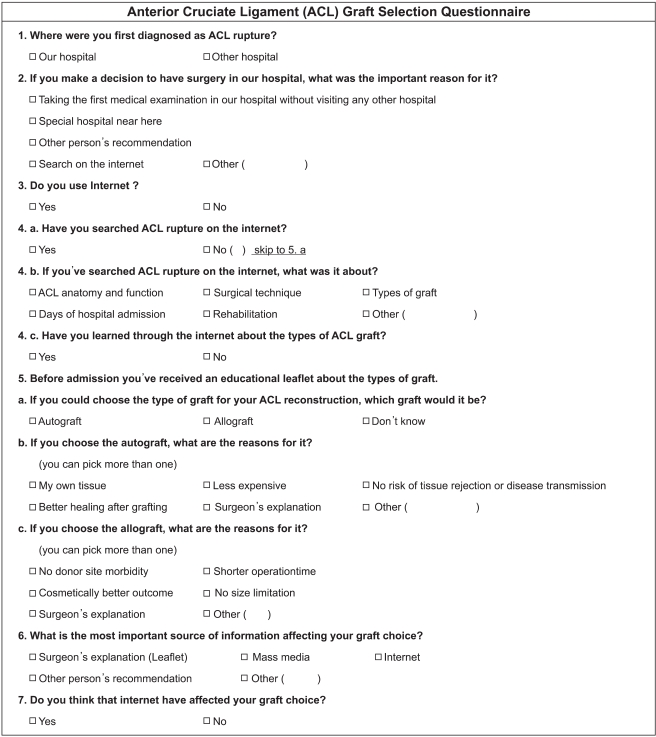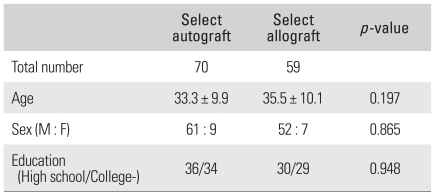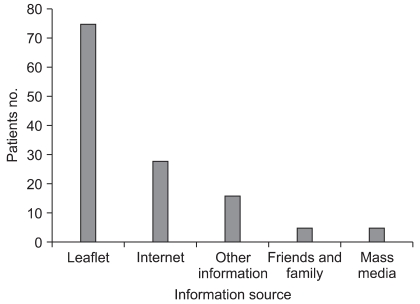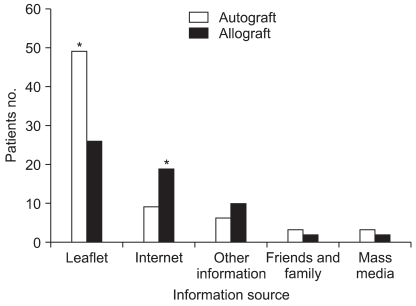Abstract
Background
Multiple studies have reported that allografts are acceptable alternatives to autografts for anterior cruciate ligament (ACL) reconstructions. Our clinical practice allows patient involvement in graft decision-making. This study examined the patients' preference for graft selection and the factors affecting their decision.
Methods
Patients scheduled to undergo an ACL reconstruction surgery (n = 129) at a university medical center in Korea were enrolled in this study. Information leaflets with graft descriptions were provided prior to hospital admission, and the patients were allowed to choose one of two surgical graft types. The patients were asked to complete a questionnaire that reflected their decision-making processes, and the patients' trends and factors affecting their choice of graft were analyzed based on their responses.
Results
Most patients (54.3%) selected autografts for the ACL reconstruction. The surgeon's explanation was the most important factor affecting the final patient decision followed by the information derived from Internet searches. Patients who derived the majority of their understanding of the graft types from the Internet chose allografts at significantly higher rates.
Conclusions
Patient graft selection is a reasonable way of designating the type of surgical procedure. Most patients selected autografts for their ACL reconstruction. However, patients who performed significant Internet-based research tended to prefer allografts.
Keywords: Anterior cruciate ligament, Reconstruction, Graft, Patient preference
Graft selection in an anterior cruciate ligament (ACL) reconstruction is critical and controversial.1-3) A surgical ACL reconstruction using autografts is a method that has consistently yielded positive and effective results.4,5) However, the desire to avoid autogenous tissue sacrifice and the incidence of postoperative morbidity has prompted a consideration of alternative graft sources.6) Several studies have identified allografts as acceptable alternatives to autografts in an ACL reconstruction,7) even though large and well-controlled prospective comparison trials will still be needed to identify the optimal surgical grafts. Graft selection is dependent on the surgeon's expertise, surgeon's preference, tissue availability, patient activity level, presence of comorbidity, prior surgery, and patient's preference.8) A review of the recent literature suggests that there is no perfect graft for a ACL reconstruction. Therefore, the optimal graft should be determined individually for each patient.
According to the National Internet Development Agency of Korea (http://www.nida.or.kr), the rate of internet usage in the Korean population aged 6 and older was reported to be approximately 74.8% as of December 2006. More than 90% of individuals aged 30 years and younger are internet users. The use of the internet as a source of health care information has continued to increase, and it is important for clinicians to recognize that patients are very interested in treatment options and wish to participate in the clinical decision-making process.
This study examined the patient treatment requests in this study. The clinical efficacy of autografts and allografts were equivalent in most cases, and in these situations, the patient's preference strongly contributed to graft selection. It was hypothesized that patients would prefer an allograft after understanding the harvest site morbidity of an autograft after searching the Internet. All patients with a pending ACL reconstruction were allowed to choose their own graft types. The factors affecting their decision were evaluated by a questionnaire.
METHODS
The patients scheduled to undergo a primary ACL reconstruction surgery at a university medical center in Korea were enrolled consecutively in this study from January 2007 to December 2008. Patients who had undergone prior knee ligament surgery on either knee, or had multiple ligament injuries were excluded. One hundred and twenty-nine patients were enrolled this study. Written informed consent was obtained from all patients. All patients had a preoperatively documented ACL rupture or a deficiency detected by magnetic resonance imaging examinations. The preferred technique for ACL reconstruction in our clinic is an arthroscopic procedure using either quadruple hamstring tendon autografts or tibialis anterior tendon allografts. An independent investigator not associated with the study counseled the patients regarding the surgical procedures and the risks and benefits of each graft type during outpatient interviews. He attempted to be as neutral as possible regarding the graft choice and spent an equal amount of verbal explanation time on each graft type. Patients also received educational leaflets containing general ACL graft information with descriptions of hamstring tendon autografts and tibialis anterior tendon allografts (Fig. 1). The patients ultimately decided which graft type would be used. The participants included 113 men and 16 women with a mean age of 34.3 years (range, 15 to 57 years). The participants completed an 11-item questionnaire discussing their graft decisions on hospital admission for surgery (Fig. 2).
Fig. 1.
Patients received an information leaflet containing general ACL graft information with descriptions of a hamstring tendon autograft and tibialis anterior tendon allograft (English version of leaflet).
Fig. 2.
The patients completed an 11-item questionnaire discussing their graft decisions on hospital admission for surgery (English version of the questionnaire).
An ACL reconstruction was performed on each participant using the patient-selected graft. All arthroscopic procedures were performed by a single surgeon. The surgical procedures in autograft and allograft groups were identical except for the nature of the graft. Endobutton (Smith & Nephew, Memphis, TN, USA) was used for femoral fixation and a double fixation technique (the spike washer/screw and the bio-absorbable interference screw) was employed for tibial fixation in both groups.
The data was analyzed using SPSS ver. 13.0 (SPSS Inc., Chicago, IL, USA). The continuous variables are reported as the mean standard deviation and the categorical variables are described using frequency distributions and reported as percentages. The normally distributed continuous variables were analyzed using a Student's t-test. The categorical variables were examined using a chi-square or Fisher's exact test if the values in the cells were 5. A p-value < 0.05 was considered significant.
RESULTS
Patient Choices
All patients were willing to select their individual grafts. Most patients (n = 70) selected autografts with the remainder (n = 59) selecting allografts. There were no differences in age, gender, or education level between the two groups (Table 1). The primary reasons for autograft selection included the autogenous tissue (47.1%), no risk of disease transmission (15.7%), low cost (14.3%), better surgical incorporation (14.3%), and the surgeon's explanation (8.6%). The primary reasons for allograft selection included no harvest site morbidity (47.4%), better cosmesis (23.7%), the surgeon's explanation (15.3%), shorter operation times (11.9%), and no graft size limitation (1.7%).
Table 1.
Patients Demographics
Factors Affecting Graft Choice
Fig. 3 shows the information sources affecting the graft choice for all participants. Of 129 patients, 75 (58.1%) responded that the most important contributor to their choice of graft was the surgeon's explanation, as described in the leaflet provided. This was followed by the Internet (28 patients, 21.7%), other information (16 patients, 12.4%), recommendations by family and friends (5 patients, 3.8%), and mass media (5 patients, 3.8%). The leaflet was the most important source of information in 70% of respondents that affected the choice of autografts, as the preferred surgical procedure, followed by the Internet (12.8%), other information (8.6%), mass media (4.3%), and the recommendations by family and friends (4.3%). The surgeon's explanation was also the most important criterion for the choice of allograft as the preferred surgical procedure (44.1%), followed by the Internet (32.2%), other information (16.9%), mass media (3.4%), and recommendations by family and friends (3.4%). Although the leaflet was the most important contributor to the patient's choice of graft in both autograft and allograft groups, the proportions in each group were significantly different (70% in the autograft group vs. 44.1% in the allograft group, p = 0.003). Fig. 4 shows the conditions affecting the graft choice in the autograft and allograft groups, which were significantly different (p = 0.025).
Fig. 3.
Information sources affecting the choice of graft in all patients.
Fig. 4.
Information sources affecting the choice of graft in the autograft and allograft groups. The proportions of leaflet and internet (*) between the autograft and allograft groups were significantly different (p = 0.003, p = 0.008, respectively).
Impact of the Internet
A total of 104 patients (80.6%) consulted the Internet for graft information prior to decision-making. There were no significant differences in Internet search rates between the autograft individuals (n = 53, 75.7%) and allograft individuals (n = 51, 86.4%, p = 0.125). Patients with regular Internet access searched for information on surgical techniques, graft types, days of hospitalization, and other characteristics of surgery. Of all internet searches (n = 104), 64 patients (61.5%) answered they acquired their graft information from the Internet. The percentage of patients who acquired graft information from the Internet was significantly higher in the allograft group (40/59, 67.8%) than the autograft group (24/70, 34.3%, p < 0.001). Overall, 24.3% of autograft group patients (n = 17) and 47.5% of allograft patients (n = 28) used the Internet to influence their choice of graft (p = 0.006).
DISCUSSION
The bone-patellar tendon-bone (BPTB) and hamstring tendon autografts are the most common grafts in ACL reconstructions.1) The BPTB autograft is frequently chosen because of its excellent clinical results and high level of patient satisfaction after a long term follow-up.4,9) Some studies suggested that a harvest of the central third of the patellar tendon might have associated donor site morbidity, such as patellofemoral osteoarthritis, patellar tendon shortening, loss of terminal extension, and patellofemoral pain.5,10,11) There has been an increase in the popularity of hamstring tendons as autografts for ACL reconstructions, which can avoid harvest site morbidity.1) However, Aune et al.12) reported that hamstring tendons exhibited inferior flexion strength at the 24 month follow-up. Debates over graft selection are likely to persist with the presence of autograft harvest site morbidity.
The potential advantages of allograft placement include autograft benefits without donor site morbidity. Krych et al.7) performed a meta-analysis of autograft and allograft stability data, and reported that the BPTB autograft procedure had less graft failure and a better functional outcome (as measured by the single leg hop test). However, all measurable outcomes were similar when irradiated and chemically processed grafts were excluded from the analysis. This suggests that the allograft choice is dependent on cost, the potential for disease transmission, sterilization protocols and their impact on graft integrity and strength, immunogenicity and clinical results.
Surgeons typically choose grafts for ACL reconstructions according to their experience, preference and tissue availability. It is believed that many therapeutic decisions need to be individualized, particularly when they involve choices between possible outcomes that may be viewed differently by different patients. The patient preferences are an essential element of care giving,13) but there has been minimal research on the patient preferences on graft selection in the literature. To our knowledge, no previous study has allowed patients to choose their own graft types and examined the factors affecting their decisions. In the present study, the patients chose their own grafts to allow greater patient participation in surgical care.
ACL reconstructions are covered by the National Health Insurance in Korea. However, allograft use is covered by insurance only if autograft sources are unavailable. The patients subsidize extra allograft charges if this procedure is selected electively. Autograft ACL reconstruction costs approximately US$1,500, whereas an allograft ACL reconstruction costs approximately US$3,000. The ACL reconstruction patients were hospitalized for 3 days postoperatively regardless of the graft type. The majority of participants in this study selected autografts. None of the participants asked the surgeons to choose their graft type or were hesitant to make their choices. Although the socioeconomic status of the autograft and allograft groups could not be compared directly, the data suggests that the cost of an allograft in Korea is a significant deterrent to its selection. However, there were no significant differences in education levels between the two groups. The results may vary in regions or countries where the costs are comparable.
The surgeon's explanation (with educational leaflets) was the most important source of information contributing to the choice of graft in both autograft and allograft groups. However, there was a significant difference in the proportion of sources of information between the groups. The use of Internet-derived health information has increased rapidly and has been termed the "e-patient revolution."14) Gerber and Eiser15) reported that Internet-derived health information may provide additional information to patients, lead to better health outcomes, and allow a more appropriate use of health service resources. On the other hand, the quality of information on the Internet can be highly variable and may limit its use as a visible information source.16) More patients in the allograft group stated that the Internet affected their graft decisions. Internet searches using the keywords "anterior cruciate ligament," were conducted using the three most popular search engines in Korea (www.naver.com, www.daum.net, kr.yahoo.com). The sponsored links, blogs, and news were reviewed. Information on the ACL anatomy, injury, surgery, graft type, and rehabilitation was acquired, but were unable to locate sites showing the superiority of one graft type over another.
This study had several limitations. First, the educational leaflet for graft information and the questionnaire evaluating the patients' choice were developed in house. There is some concern as to whether the leaflet and questionnaire introduced bias. These documents may require revision by professional societies in the future. Second, regardless of how carefully the investigator tried to be neutral regarding the graft choice and spend an equal amount of verbal explanation time on each graft type, his own personal bias might have been reflected in his presentation, which may have guided the patient toward one of the two choices. Third, the patients were offered only one of two different graft choices. There are many other graft choices reported in the literature, including quadriceps tendon, BPTB, Achilles tendon allograft, and other possible options. The patient's decision was limited to the graft type and no choices regarding other surgical options were offered. It is believed that autogenous tissue harvest and allogeneic tissue use are critical issues to specific individuals, and decisions regarding other surgical portions of ACL reconstruction should remain the surgeon's choice.
In conclusion, patient graft selection is a reasonable way of designating the type of surgical procedure. Most patients selected autografts for their ACL reconstruction. However, patients who performed significant Internet-based research preferred allografts. These results suggest that surgeons must acknowledge the Internet's influence in their patient populations. It is important to be aware of the magnitude and quality of the health care information available on the Internet due to its significant influence on patient graft decisions in ACL reconstruction surgery.
Footnotes
No potential conflict of interest relevant to this article was reported.
References
- 1.Sherman OH, Banffy MB. Anterior cruciate ligament reconstruction: which graft is best? Arthroscopy. 2004;20(9):974–980. doi: 10.1016/j.arthro.2004.08.001. [DOI] [PubMed] [Google Scholar]
- 2.Eriksson E. Auto- or allograft for ACL-reconstruction? Knee Surg Sports Traumatol Arthrosc. 2007;15(6):689. doi: 10.1007/s00167-007-0354-4. [DOI] [PubMed] [Google Scholar]
- 3.Barber FA. Should allografts be used for routine anterior cruciate ligament reconstructions? Arthroscopy. 2003;19(4):421. doi: 10.1053/jars.2003.50130. [DOI] [PubMed] [Google Scholar]
- 4.Salmon LJ, Russell VJ, Refshauge K, et al. Long-term outcome of endoscopic anterior cruciate ligament reconstruction with patellar tendon autograft: minimum 13-year review. Am J Sports Med. 2006;34(5):721–732. doi: 10.1177/0363546505282626. [DOI] [PubMed] [Google Scholar]
- 5.Pinczewski LA, Lyman J, Salmon LJ, Russell VJ, Roe J, Linklater J. A 10-year comparison of anterior cruciate ligament reconstructions with hamstring tendon and patellar tendon autograft: a controlled, prospective trial. Am J Sports Med. 2007;35(4):564–574. doi: 10.1177/0363546506296042. [DOI] [PubMed] [Google Scholar]
- 6.Marrale J, Morrissey MC, Haddad FS. A literature review of autograft and allograft anterior cruciate ligament reconstruction. Knee Surg Sports Traumatol Arthrosc. 2007;15(6):690–704. doi: 10.1007/s00167-006-0236-1. [DOI] [PubMed] [Google Scholar]
- 7.Krych AJ, Jackson JD, Hoskin TL, Dahm DL. A meta-analysis of patellar tendon autograft versus patellar tendon allograft in anterior cruciate ligament reconstruction. Arthroscopy. 2008;24(3):292–298. doi: 10.1016/j.arthro.2007.08.029. [DOI] [PubMed] [Google Scholar]
- 8.West RV, Harner CD. Graft selection in anterior cruciate ligament reconstruction. J Am Acad Orthop Surg. 2005;13(3):197–207. doi: 10.5435/00124635-200505000-00006. [DOI] [PubMed] [Google Scholar]
- 9.Lebel B, Hulet C, Galaud B, Burdin G, Locker B, Vielpeau C. Arthroscopic reconstruction of the anterior cruciate ligament using bone-patellar tendon-bone autograft: a minimum 10-year follow-up. Am J Sports Med. 2008;36(7):1275–1282. doi: 10.1177/0363546508314721. [DOI] [PubMed] [Google Scholar]
- 10.Mauro CS, Irrgang JJ, Williams BA, Harner CD. Loss of extension following anterior cruciate ligament reconstruction: analysis of incidence and etiology using IKDC criteria. Arthroscopy. 2008;24(2):146–153. doi: 10.1016/j.arthro.2007.08.026. [DOI] [PubMed] [Google Scholar]
- 11.Breitfuss H, Frohlich R, Povacz P, Resch H, Wicker A. The tendon defect after anterior cruciate ligament reconstruction using the midthird patellar tendon: a problem for the patellofemoral joint? Knee Surg Sports Traumatol Arthrosc. 1996;3(4):194–198. doi: 10.1007/BF01466615. [DOI] [PubMed] [Google Scholar]
- 12.Aune AK, Holm I, Risberg MA, Jensen HK, Steen H. Four-strand hamstring tendon autograft compared with patellar tendon-bone autograft for anterior cruciate ligament reconstruction: a randomized study with two-year follow-up. Am J Sports Med. 2001;29(6):722–728. doi: 10.1177/03635465010290060901. [DOI] [PubMed] [Google Scholar]
- 13.Kassirer JP. Incorporating patients' preferences into medical decisions. N Engl J Med. 1994;330(26):1895–1896. doi: 10.1056/NEJM199406303302611. [DOI] [PubMed] [Google Scholar]
- 14.Akerkar SM, Bichile LS. Doctor patient relationship: changing dynamics in the information age. J Postgrad Med. 2004;50(2):120–122. [PubMed] [Google Scholar]
- 15.Gerber BS, Eiser AR. The patient physician relationship in the Internet age: future prospects and the research agenda. J Med Internet Res. 2001;3(2):E15. doi: 10.2196/jmir.3.2.e15. [DOI] [PMC free article] [PubMed] [Google Scholar]
- 16.Eysenbach G, Diepgen TL. Towards quality management of medical information on the internet: evaluation, labelling, and filtering of information. BMJ. 1998;317(7171):1496–1500. doi: 10.1136/bmj.317.7171.1496. [DOI] [PMC free article] [PubMed] [Google Scholar]



